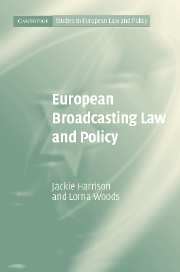Book contents
- Frontmatter
- Contents
- Series Editors' Preface
- Preface
- Case list
- PART I
- PART II
- 6 Access
- 7 Media ownership: impact on access and content
- 8 Jurisdiction, forum shopping and the ‘race to the bottom’
- 9 Advertising placement and frequency: balancing the needs of viewers and commercial interests
- 10 Negative content regulation
- 11 Positive content regulation: quotas
- 12 Privatisation of sport and listed events
- 13 State aid: constraints on public service broadcasting
- PART III
- Appendix
- Bibliography
- Index
7 - Media ownership: impact on access and content
Published online by Cambridge University Press: 29 July 2009
- Frontmatter
- Contents
- Series Editors' Preface
- Preface
- Case list
- PART I
- PART II
- 6 Access
- 7 Media ownership: impact on access and content
- 8 Jurisdiction, forum shopping and the ‘race to the bottom’
- 9 Advertising placement and frequency: balancing the needs of viewers and commercial interests
- 10 Negative content regulation
- 11 Positive content regulation: quotas
- 12 Privatisation of sport and listed events
- 13 State aid: constraints on public service broadcasting
- PART III
- Appendix
- Bibliography
- Index
Summary
Introduction
As chapter 6 has shown, the actions of private parties, particularly the big and powerful, may have an impact on the content available to viewers. Put briefly, limiting the range of different suppliers may adversely affect the range of content broadcast. Similar concerns about access, and the consequent impact on the range of content available, arise in the context of media mergers. These are particularly significant given the developments in the media market. Mergers and convergence of media corporations with each other and related corporations, throughout the 1990s and into the twenty-first century, have created vertically integrated media conglomerates and a greater concentration of ownership of media assets. According to Anup Shah (citing Bagdikian) in 1983 50 corporations dominated most of each type of mass medium and the biggest media merger in history was valued at $340 million. In 1987 those 50 corporations had shrunk to 29, to 23 in 1990. By 1997 the 23 had reduced to 10 and included the $19 billion Disney–ABC deal, at the time the biggest media merger ever. In 2000 AOLTime Warner's $350 billion merged corporation was more than 1,000 times larger than the biggest deal of 1983. The Nation magazine in 2002 listed the top ten or ‘big ten’ media corporations as AOL Time Warner, Disney, General Electric, News Corporation, Viacom, Vivendi, Sony, Bertelsmann, AT&T and Liberty Media. Each of these corporations is global in reach and vertically integrated.
- Type
- Chapter
- Information
- European Broadcasting Law and Policy , pp. 146 - 172Publisher: Cambridge University PressPrint publication year: 2007



